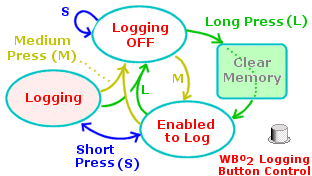


The 2A0 (shown at right) & 2A1 (shown at left) are Tech Edge's second generation wideband units and our first fully digital units. The 2A is specifically designed for the inexpensive Bosch LSU sensor. 2A also works with the NTK (L1H1 & L2H2, or UEGO, sensors) although we recommend the lower priced Bosch LSU sensors for best performance and value. Features include a wideband linear (5 Volt, 12 bit DAC) output, a Simulated Narrowband output (10 bit PWM), and an analogue display output (10 bit PWM). All outputs can be re-programmed and their functions swapped with the WB config program. A logger too! 2A is not only a Lambda/AFR sensing unit, but includes a built-in logger with non-volatile on-board storage memory. 2A0 comes with 32 kbytes of on-board logging memory, 2A1 has 1 M byte (32 times more). Both are able to log RPM, 3 analogue user channels (0 to 5 Volt inputs), and 3 thermocouple inputs. Standard DIY kit cable lengths of 2.6 m and 4.0 m are available. |
2A0/2A1
![]() | New 3A Range
| New 2Y DIY kit
| 2A0/1 DIY Kit
| Logging
| Connectors
| RJ45 Splitter
| Changes
| New 3A Range
| New 2Y DIY kit
| 2A0/1 DIY Kit
| Logging
| Connectors
| RJ45 Splitter
| Changes![]()
Tech Edge 2A0/1 Features
- Available ONLY in DIY form ! (from February 2007)
- Accuracy within 0.1 AFR (Lambda +/- 0.005).
- 10.5 to 19.5 Volt DC operation (up to 3 Amps).
- Uses LSU 4.0/4.2 (Bosch 6066/7057 family) or NTK (L1H1/L2H2) sensor.
- WBlin Configurable wideband 5 Volt output (12 bit accuracy).
- SVout for LD01 display (10 bit configurable too).
- NBsim narrowband (10 bit configurable too).
- On-board logging memory and RS232 logging to PC, etc.
- memory size of 32 kByte for 2A0, 1 M Byte for 2A1.
- 3 analogue 0 to 5 Volt inputs sampled at up to 40/sec.
- 3 thermocouple inputs (can be converted to analogue inputs).
- RPM input from Tacho or ECU for logging.
- Free logging software (optional extra feature upgrade available).







 As well, an RS232 data stream provides digitally precise information on sensed AFR and all logged inputs.
These outputs are described in detail in the following paragraphs.
Note: Pin 3/Y1 refers to pin 3 on the 8 pin RJ45 connector Y1.
As well, an RS232 data stream provides digitally precise information on sensed AFR and all logged inputs.
These outputs are described in detail in the following paragraphs.
Note: Pin 3/Y1 refers to pin 3 on the 8 pin RJ45 connector Y1.
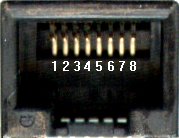

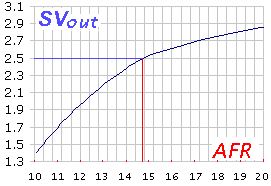
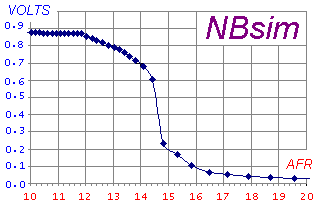
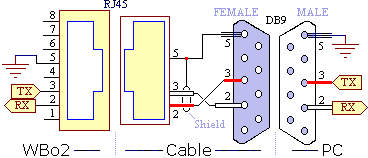

 2A0 has a green 8 pin
2A0 has a green 8 pin 









 Normal Operation :
The unit should always have a steady RED LED (unless on-board logging is active - see below).
The AMBER LED is brightly LIT but will flicker at 30 Hz (just perceptible).
The intensity of the AMBER flicker will give some idea of how much power is being used to maintain the heater's temperature.
Normal Operation :
The unit should always have a steady RED LED (unless on-board logging is active - see below).
The AMBER LED is brightly LIT but will flicker at 30 Hz (just perceptible).
The intensity of the AMBER flicker will give some idea of how much power is being used to maintain the heater's temperature.
 Normal - Heating :
Just after the unit has been turned on the normal heating cycle will cause the RED LED
to flash about once a second with a short sharp ON time, and longer OFF time.
The AMBER LED will produce a small amount of flicker (30 Hz), but should be brightly LIT.
This should last 20 to 30 seconds for a cold sensor.
If the time is much over 30 seconds then either the battery voltage may be low
or the sensor is placed where it is being excessively cooled by the gas flowing past it.
A cool sensor position may result in reduced sensor life and inaccurate measurements.
Normal - Heating :
Just after the unit has been turned on the normal heating cycle will cause the RED LED
to flash about once a second with a short sharp ON time, and longer OFF time.
The AMBER LED will produce a small amount of flicker (30 Hz), but should be brightly LIT.
This should last 20 to 30 seconds for a cold sensor.
If the time is much over 30 seconds then either the battery voltage may be low
or the sensor is placed where it is being excessively cooled by the gas flowing past it.
A cool sensor position may result in reduced sensor life and inaccurate measurements.
 Error - No Heating :
If the sensor cable is disconnected or damaged,
the battery voltage too low or too high,
or some other problem with the heater circuit occurs,
the RED LED will flash with a fast regular ON - OFF beat twice a second
While these conditions remain the AMBER LED will be mostly DIM
but will produce a very sharp flicker a few times a second
(the unit is looking for sensor or sampling battery voltage).
This condition can occur during starting or when there is excessive battery drain during idle.
It may be an indication of a poor battery or alternator/regulator, or connection to the wrong point of the vehicle's wiring.
Error - No Heating :
If the sensor cable is disconnected or damaged,
the battery voltage too low or too high,
or some other problem with the heater circuit occurs,
the RED LED will flash with a fast regular ON - OFF beat twice a second
While these conditions remain the AMBER LED will be mostly DIM
but will produce a very sharp flicker a few times a second
(the unit is looking for sensor or sampling battery voltage).
This condition can occur during starting or when there is excessive battery drain during idle.
It may be an indication of a poor battery or alternator/regulator, or connection to the wrong point of the vehicle's wiring.

 A wideband PID is now indicated by a sharp double OFF flash as shown here.
If you have earlier firmware and need to differentiate between the two conditions
then download the latest
A wideband PID is now indicated by a sharp double OFF flash as shown here.
If you have earlier firmware and need to differentiate between the two conditions
then download the latest 
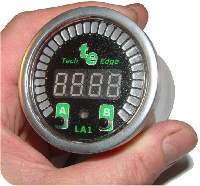 or just less than 2 minutes. The Logging rate can be varied up to around 50 frames/sec (23 seconds of logging)
or down to less than a frame every 2 seconds (about 40 minutes). Logging
or just less than 2 minutes. The Logging rate can be varied up to around 50 frames/sec (23 seconds of logging)
or down to less than a frame every 2 seconds (about 40 minutes). Logging  slow flash (on-off every 2 seconds) = enabled for logging.
slow flash (on-off every 2 seconds) = enabled for logging.
 double flash (two flashes every second) = logging.
double flash (two flashes every second) = logging.
